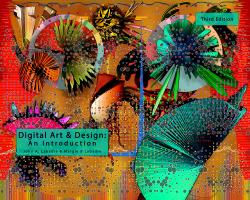Digital Art and Design: An Introduction
Author(s): John Antoine Labadie , Margie Beth Labadie
Edition: 3
Copyright: 2021
The innovative electronic textbook Digital Art and Design: An Introduction is written at an introductory level and provides readers with factually correct information about wide-ranging subject areas directly related to digital art and design. This text provides a clear and thorough introduction to the history of digital art and design, digital tools, and creative digital practice. The topics included in this revised and expanded third edition includes, among others: important innovators in the history of computing; overviews of computer hardware, software and peripherals; a gallery of contemporary digital artists and designers; and chapters dealing with video games, animation, special effects, digital photography and videography. A bibliography, a glossary, and a section including short articles on specific digital artists and designers are also included. Ancillary materials consisting of a test bank, and chapter-by-chapter presentation slides will soon be available.
Chapter 1: The Evolution of Human Creative Behavior
Chapter 2: Pioneers of Digital Art and Design
Chapter 3: Some Questions About Computing
Chapter 4: Brief History of Digital Art
Chapter 5: Brief History of Digital Design
Chapter 6: Contemporary Creative Practice in Digital Art and Design
Chapter 7: Computer Hardware
Chapter 8: Computer Software
Chapter 9: Computer Peripherals
Chapter 10: Digital Photography and Videography
Chapter 11: Video Games
Chapter 12: Animation and Special Effects
Chapter 13: Criticism and Curation in a Digital World
Chapter 14: Intellectual Property in a Digital World
Chapter 15: The Digital Horizon
Bibliography
Glossary
Introduction to Digital Art is an excellent text written in a conversational manner. It is approachable and yet full of depth. And it is a wonderful introduction to a relatively new subject of study.
Gina Gibson | Associate Professor, Fine Arts - Graphic Media
Black Hills State University
It is incredibly challenging to cover the broad range of topics & ideas encompassed in this textbook. Introduction to Digital Art does a very good job of laying the groundwork for further study in the individual disciplines & areas covered in the text.
Rick Allen | Underwater Videographer and Educator
Nautilus Productions
The innovative electronic textbook Digital Art and Design: An Introduction is written at an introductory level and provides readers with factually correct information about wide-ranging subject areas directly related to digital art and design. This text provides a clear and thorough introduction to the history of digital art and design, digital tools, and creative digital practice. The topics included in this revised and expanded third edition includes, among others: important innovators in the history of computing; overviews of computer hardware, software and peripherals; a gallery of contemporary digital artists and designers; and chapters dealing with video games, animation, special effects, digital photography and videography. A bibliography, a glossary, and a section including short articles on specific digital artists and designers are also included. Ancillary materials consisting of a test bank, and chapter-by-chapter presentation slides will soon be available.
Chapter 1: The Evolution of Human Creative Behavior
Chapter 2: Pioneers of Digital Art and Design
Chapter 3: Some Questions About Computing
Chapter 4: Brief History of Digital Art
Chapter 5: Brief History of Digital Design
Chapter 6: Contemporary Creative Practice in Digital Art and Design
Chapter 7: Computer Hardware
Chapter 8: Computer Software
Chapter 9: Computer Peripherals
Chapter 10: Digital Photography and Videography
Chapter 11: Video Games
Chapter 12: Animation and Special Effects
Chapter 13: Criticism and Curation in a Digital World
Chapter 14: Intellectual Property in a Digital World
Chapter 15: The Digital Horizon
Bibliography
Glossary
Introduction to Digital Art is an excellent text written in a conversational manner. It is approachable and yet full of depth. And it is a wonderful introduction to a relatively new subject of study.
Gina Gibson | Associate Professor, Fine Arts - Graphic Media
Black Hills State University
It is incredibly challenging to cover the broad range of topics & ideas encompassed in this textbook. Introduction to Digital Art does a very good job of laying the groundwork for further study in the individual disciplines & areas covered in the text.
Rick Allen | Underwater Videographer and Educator
Nautilus Productions

